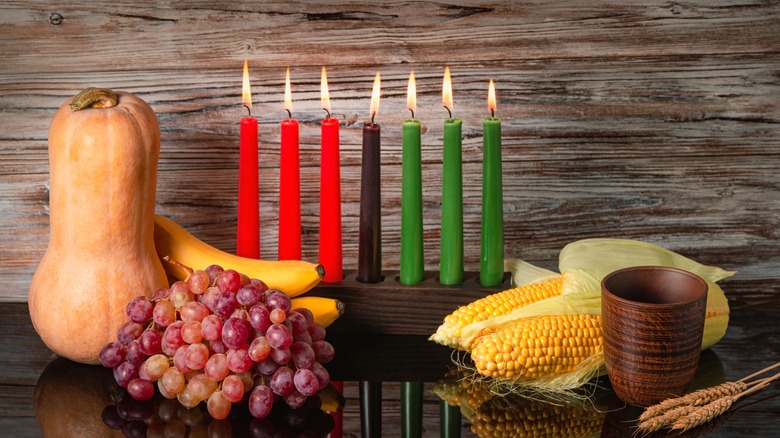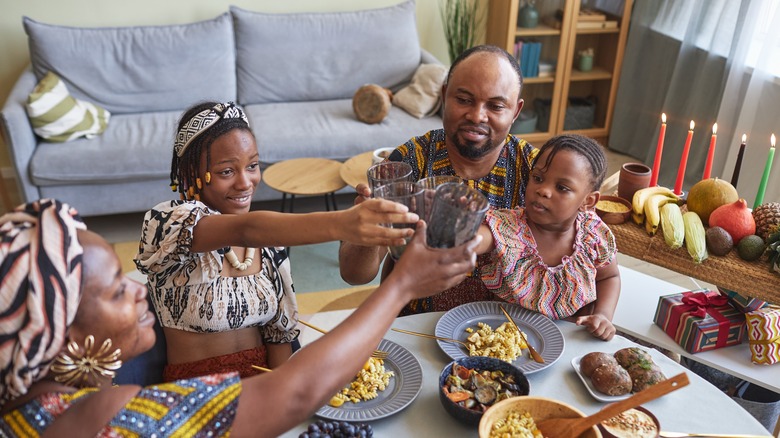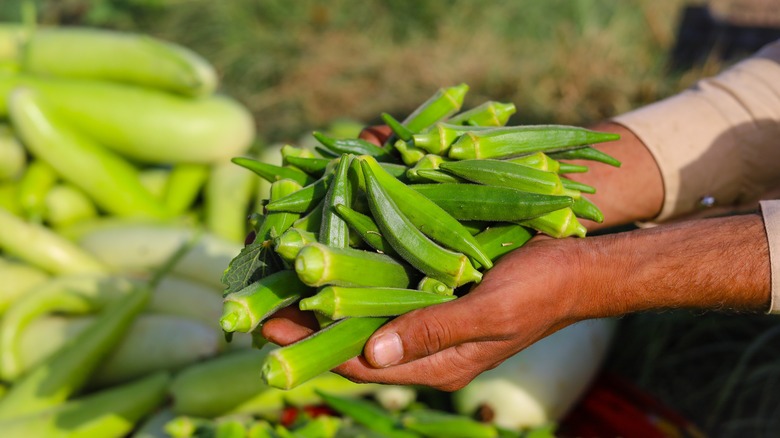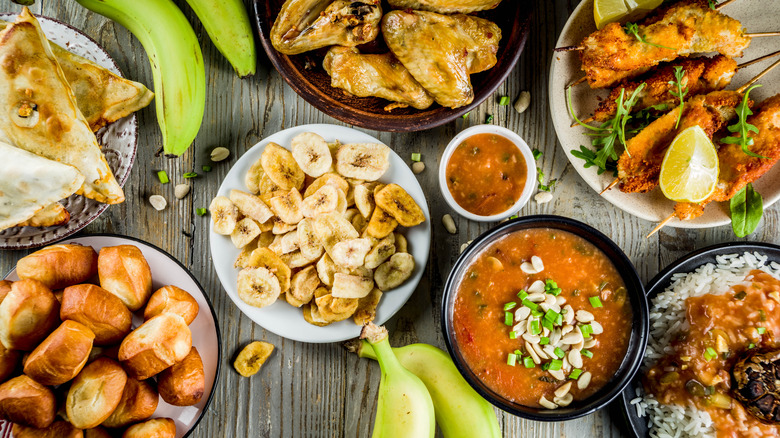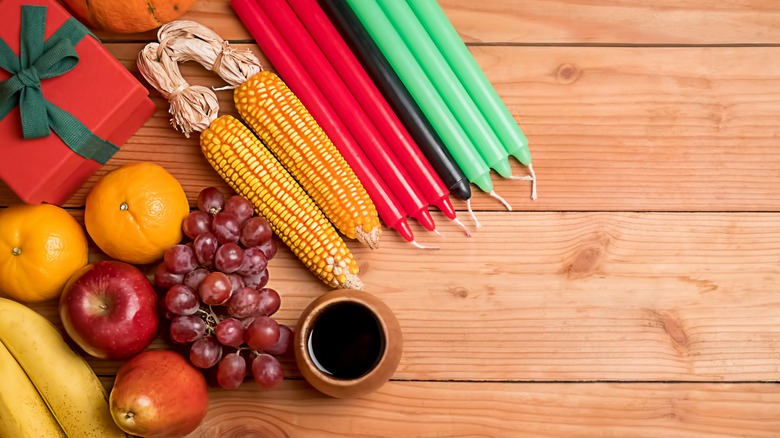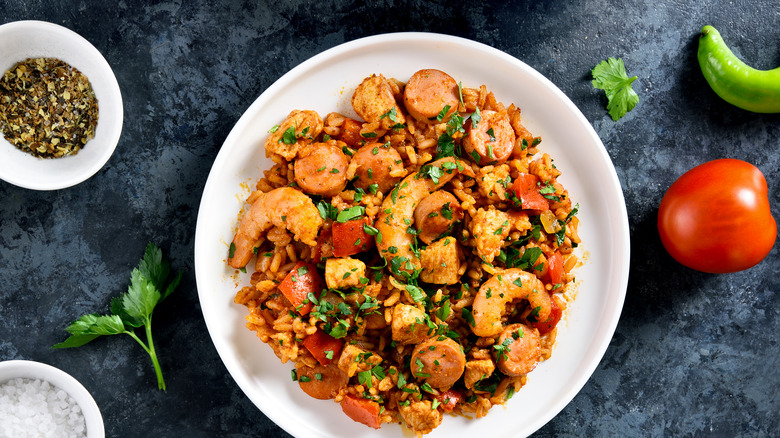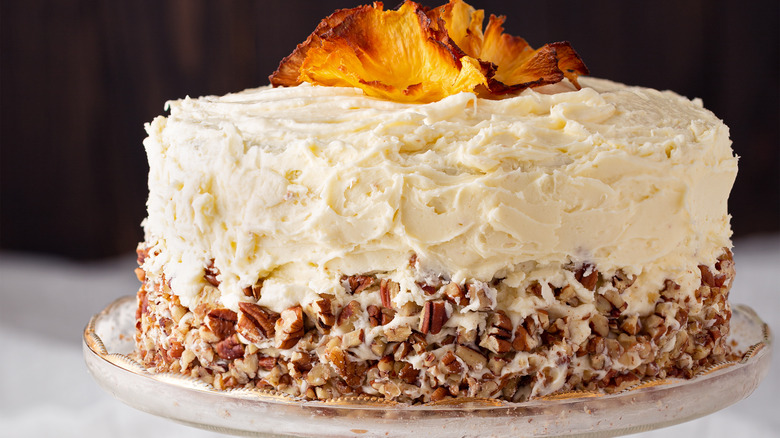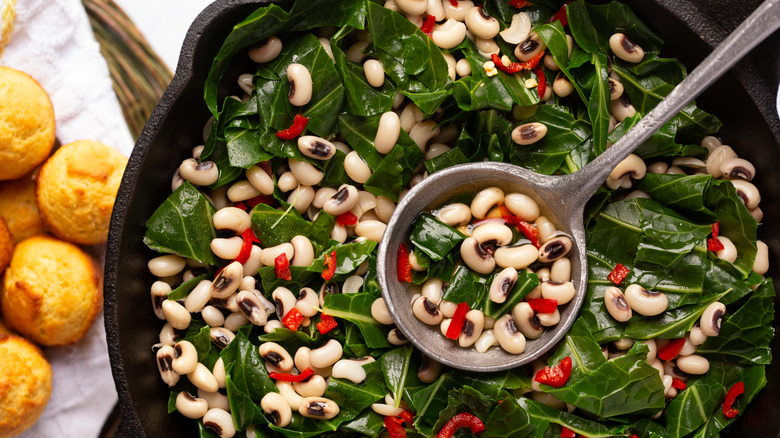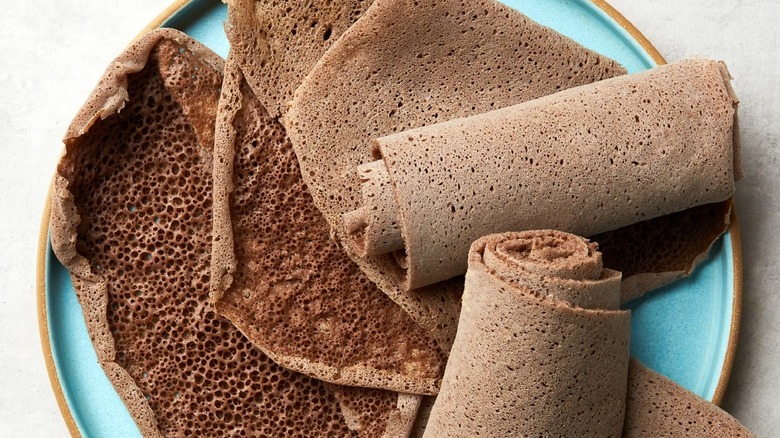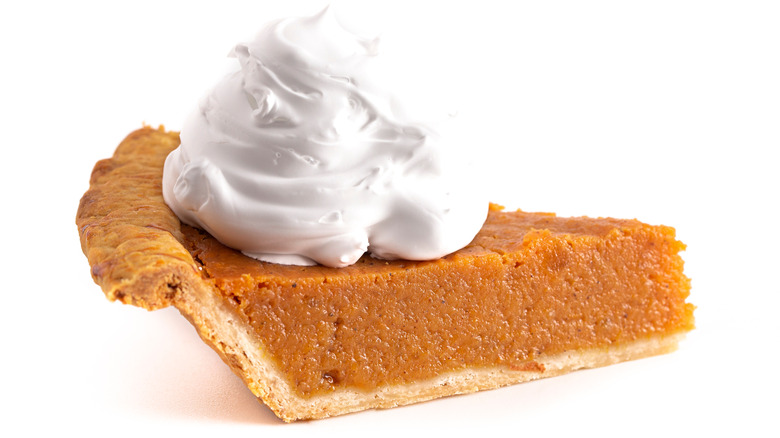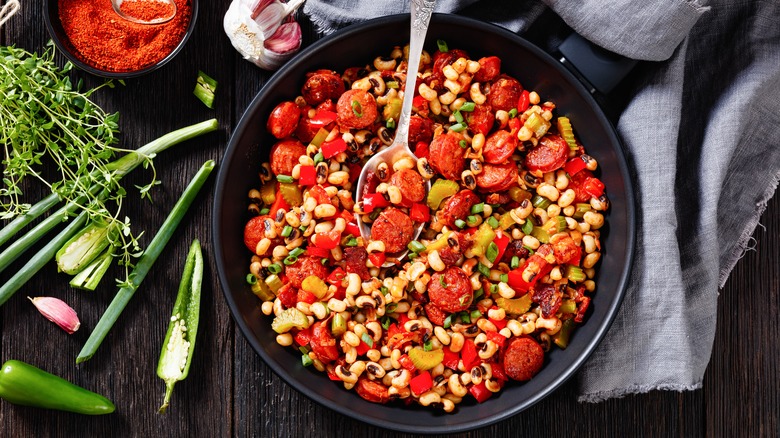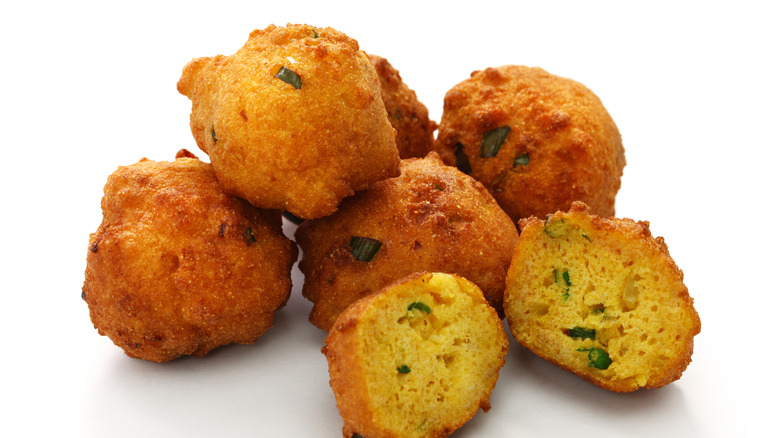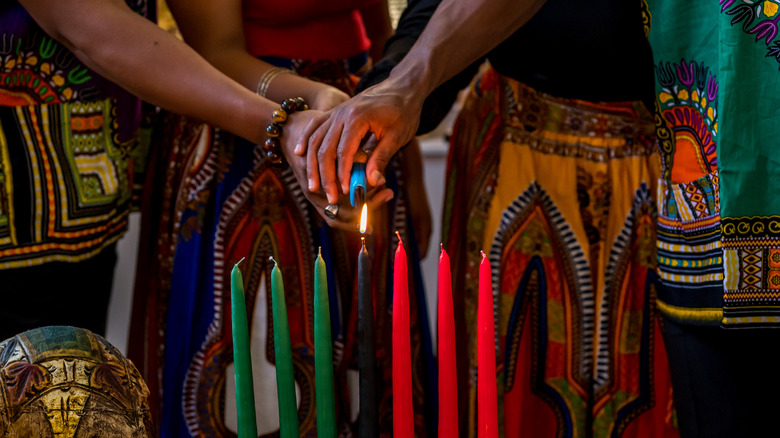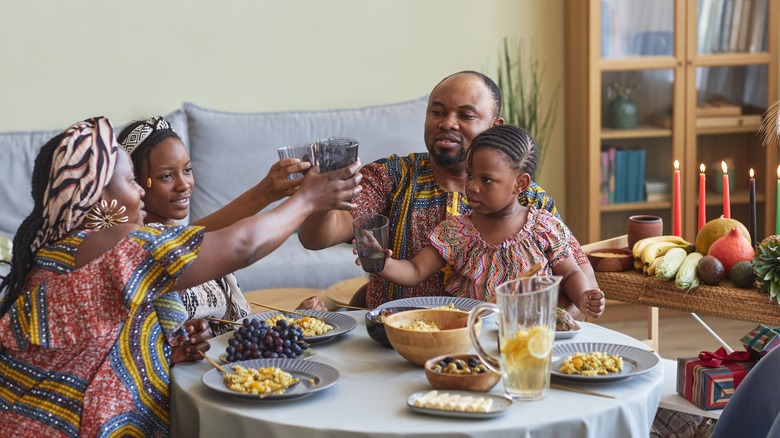14 Kwanzaa Food Traditions You Should Know About
How much do you actually know about the Kwanzaa holiday? According to History, Kwanzaa was officially recognized as a holiday in the 1960s to empower and connect Black communities after the wake of the Watts riots. The name of the holiday ties back to the Swahili phrase "matunda ya kwanza," meaning the first harvest. The second "a" was added after the seven children of the first Kwanzaa celebration in 1966, of whom each was granted a letter in the name of the holiday.
Although Kwanzaa is celebrated in the seven days following Christmas, many folks associate the two holidays as one. In reality, Kwanzaa is a holiday that centers around seven principles, including umoja (unity), kujichagulia (self-determination), ujima (collective work and responsibility), ujamaa (cooperative economics), nia (purpose), kuumba (creativity) and imani (faith), notes History. Following the end of Kwanzaa, attendees offer homemade or culturally-themed gifts to one another.
A big part of Kwanzaa, like other holidays around the same time, is the food. Here are some of the food traditions that are unique to Kwanzaa.
1. The largest meal is eaten on the sixth night
Kwanzaa lasts seven days — starting on December 26 and ending on January 1. The sixth night, which falls on New Year's Eve, begins with the lighting of the black candle to symbolize the sixth Kwanzaa principle — kuumba. Kuumba symbolizes creativity, and the sixth night of Kwanzaa is without a doubt creative, (via Praise Indy).
Besides the celebration of this principle, the sixth night also features the Kwanzaa Feast, otherwise known as Kwanzaa Karamu. For this feast, families invited loved ones and friends into their homes, decorated with Kwanzaa decorations, Pan-African decor, and music. There also may be some passage reading and plays to exemplify the kuumba (creativity). At the beginning of the feast, all of the guests drink from a unity cup that symbolizes an acknowledgment of the ancestors, notes Praise Indy.
At the end of the Karamu, the eldest member reads the Tamshi La Tutaonana — a farewell statement to the year and the closing of the Karamu, says Praise Indy.
2. Foods of the African diaspora have become more common at Kwanzaa feasts
Many of the foods eaten at the Karamu are significant to modern Black culture as well as Black history. According to the Oldways Nutrition Exchange (ONE), many of the foods eaten during the Kwanzaa feast are products of the African Diaspora — the mass forced movement of African people from the African continent during the Transatlantic Slave Trade between the 1500s and the 1800s. The movement of African people out of the continent and into the Caribbean and the Americas resulted in hybridized cuisines, many of which are represented by the fare served on Karamu (via ONE).
Afro-Caribbean cuisines, for example, includes the inclusion of French, Spanish, and African ingredients and cooking. It isn't uncommon to see seafood like salt fish, guava, red beans, and pigeon peas on the table — all of which have been influenced by the availability of foods on the Caribbean Islands. Southern soul cooking, influenced by French cooking and the ingredients available in the Southern United States, include ingredients grown in gardens like okra, collards, and tomatoes, as well as seafood like oysters, crabs, and shrimp.
3. Regional variations on food served during Kwanzaa
Not all of the food served at the Kwanzaa Karamu is the same from table to table. In fact, there are a ton of variations based on the cultures and regions represented. According to the Tenement Museum, some families use the food on Kwanzaa Karamu as a way to reflect their forced migration, or on the other side of the coin, the family's immigration to a new country. Ghanian families may prepare a groundnut stew, a creamy simmered soup made with groundnut paste (often substituted with peanut butter), protein ranging from chicken to tripe, and a hefty dose of spicy peppers, with a side of jollof rice, notes Egunsi Foods.
Senegalese families may prepare thieboudienne, a rice dish served with stuffed salted fish and stewed vegetables, (via the Matador Network). Regardless of the cuisines represented, the most important part is that there is plenty of food to share among guests.
4. Mazoa and Muhindi are two symbolic foods served
There are seven simples to accompany the Kwanzaa holiday. The symbols include mazao (crops), mkeka (mat), kinara (candleholder), muhindi (corn), kikombe cha umoja (unity cup), zawadi (gifts), and mishumaa saba (seven candles) — all of which are on the table for the Kwanzaa Feast (via Stratford Crier). The mazao symbolizes the African harvest and rewards of collaborative and productive labor, while the corn is emblematic of the cultural significance of children and the future, notes the Official Kwanzaa Website. One ear of corn is placed on the table for each child that the family has, or expects to have. If there are no children, one ear is left on the table to symbolize the children in the community, adds Why Christmas.
Why Christmas notes that the selection of mazao usually contains bananas, plantains, mango, and peaches, all of which are shared with the guests at the table.
5. The main meal of Karamu is usually a one-pot stew or soup
The Kwanzaa feast is usually brought together by a single one-pot soup or stew. While some of the common one-pot offerings include the aforementioned peanut stew and Senegalese thieboudienne, other Kwanzaa feasts include jambalaya, a rice dish cooked with saffron, chicken, and regional seafood staples like mussels and shrimp. Jambalaya also receives a meaty kick from the inclusion of andouille sausage and the crunch from cooked pepper and onions. Another one-pot meal is the Philadelphian pepper pot — a stew made with tripe along with various cheap cuts of meat and veggies. According to The Encyclopedia of Greater Philadelphia, the Philadelphia region in the 1700s following the movement of food from the Caribbean was where the dish originated. The original pepper pot was either made of cassareep, a sweet-and-sour flavor from the cassava root, or callaloo made from a medley of West African greens.
The side dishes of Kwanzaa are made to complement the main one-pot dish. Nigerian jollof rice is one common staple for Kwanzaa. This rice dish contains a bit of heat from curry powder as well as a bit of saltiness from dried crayfish and freshness from peppers.
6. Karamu dishes include the first fruits of the harvest
The first foods of the harvest in many African countries likely included mango, pineapple, okra, oranges, eggplant, and yams, (via the Institute of Culinary Education). These ingredients make their way to the Kwanzaa table often in the form of side dishes. Okra can be served as a pan-fried dish or in a shrimp gumbo flavored with Creole seasoning and various different kinds of peppers. Candied yams are another recipe on Kwanzaa; these sliced yams are covered in a sweet, unctuous mixture of butter, molasses, and brown sugar before being baked until tender.
Pineapples are often used for sweet applications during the Kwanzaa Feast, including hummingbird cake. This cake is similar to the texture of a carrot cake but includes pineapple and bananas instead of carrots for moisture and texture, and comes with a hint of nuttiness from the inclusion of chopped pecans.
7. The colors of Pan-African flag are emblematic in the food
A key part of the Kwanzaa celebration is a connection to the Pan-African flag. Many of the dishes prepared for Kwanzaa are connected to the primary colors of the flag, which is also known as the Bendera. The red on the flag symbolizes the blood shed by Africans who died in the fight for liberation, followed by the black color, emblematic of the Black identity, and the green represents the growth and fertility of the African continent, (via NPR).
Some of the most common ingredients that contain the colors of the Bendera are black-eyed peas (also known as cow peas), collard greens, and stewed tomatoes. The collard greens can be served solo or stewed with mustard and turnip greens. You may also see some instances of potlikker served on Kwanzaa — a mixture of leftover greens and animal bones in a warm, flavorful broth.
8. Black eyed peas and collard greens are Kwanzaa staples
The two foods that are almost essential to a Kwanzaa celebration are black-eyed peas and collard greens. Stewed collard greens are symbolic of good fortune, while black-eyed peas are symbolic of good luck — so it's no surprise that these two foods are important parts of the Kwanzaa Feast spread, notes Modern Farmer.
The color and the flavor of cornbread are as good as gold, and if the black-eyed peas are stewed with tomatoes, it is said that the food brings health and wealth into the new year. Some families will leave a penny or a dime inside the pot of peas. Whoever finds the coin in their peas will have luck for the rest of the new year. But for the sheer choking risk, we cannot condone adding a special metal surprise to your bean pot (or perhaps you should warn your guests that it's in there).
9. The meals usually include several different starches
No holiday meal would be the same without bread and carbs — and Kwanzaa is no different. You're likely to see a range of bread-based dishes on the Kwanzaa table. Injera is an Ethiopian flatbread made from teff flour. It's porous, flexible, and perfect for pairing with soups and thick stews. Cornbread is another popular side bread served on Kwanzaa, and otherwise frequently in traditional Southern cooking. In the Deep South, many cornbread recipes are passed down from generation to generation, along with the skillet that the bread is baked in.
Another popular side dish on Kwanzaa, but less well-known than cornbread, is called spoonbread. Spoonbread is a cornbread soufflé with the texture of bread pudding. The cornmeal and milk are leavened with egg whites, which provide a fluffy yet strong structure to the spoonbread. It is believed this bread dates back to the 1800s and the meshing of cuisines with indigenous Americans, who were the first populations to grow corn.
10. Kwanzaa doesn't neglect the sweets
Kwanzaa Feasts aren't just about the savory; there are many desserts that you can find on the table, too. Sweet potato pie, for folks who haven't had a slice, has a texture similar to pumpkin pie but is usually lighter on the spices and has a distinct kick from molasses. You're also likely to find some iterations of bread pudding that include pineapple, rum, or sweet potatoes. Coconut cake is another dessert popular on Kwanzaa for its tropical flavors and pleasant unctuous undertone.
Benne wafers are commonly eaten throughout the Karamu Feast. According to the Olde Colony Bakery, benne (the Bantu word for "sesame"), was brought through East Africa and West Africa and eventually to the Southern United States during the Trans-Atlantic Slave Trade. The wafer cookie itself is thin and slightly savory thanks to the sesame seeds. Who doesn't love a sweet and savory bite?
11. Hoppin' John is symbolic of the new year
Hoppin' John is another colorful bean dish served on Kwanzaa Karamu. The dish is made with bacon, pigeon peas, and rice. The original rice used for the recipe was exclusively Carolina Gold, which was a product of the knowledge and agricultural skill of black African labor in the American South.
According to History, there are no exact linkages between Hoppin' John and its linkages to good luck in the New Year. It is likely because African slave labor was often given off-time during Christmas and New Year's, and since there weren't many fresh crops growing at the time, Hoppin' John was a go-to for comfort and filling comfort food. Hoppin' John was served with collard greens, which resembled paper money, and golden cornbread. The peas themselves were said to resemble coins, and thus the whole dish became linked to prosperity and wealth. Families would further try to bring prosperity to their new year celebration by placing coins under dishes of Hoppin' John or adding extra pork.
12. Modify Kwanzaa recipes to be vegetarian or vegan
Although Kwanzaa revolves a lot around andouille sausage, shrimp, and crustaceans, there are many plant-based Kwanzaa recipes that can be prepared for the holiday. Macaroni and cheese can be made vegan by substituting the cheese with a mix of cashews, nutritional yeast, and seasonings. Peach cobbler is another naturally vegetarian dessert but can be made vegan with the substitution of vegan butter and an egg replacer.
Since the sixth night of Kwanzaa is defined by kuumba (creativity), you may need a hefty dose of creativity to make substitutions in the main dishes and stews. Ingredients like tempeh can bolster a dish of collard greens, while tofu can add a hefty dose of protein to soups and stews. And if you want to experiment with foods on Kwanzaa, you should always do so in good company. This holiday is about liberation, but also the collective power of love and presence.
13. The table setting is very symbolic of the holiday
Kwanzaa is a very spiritual and tradition-rich holiday, so, understandably, there has to be some order and structure to the way the tables and room are decorated for the week-long celebration. The table needs to be properly set and include the seven candles placed in a kinara (candle holder), which is then placed on top of the mat. The black candle has to be in the center of the kinara to symbolize the culture and roots of the African people, while the other six candles, red and green, illustrate the holidays' principles. The black candle must always be lit first to represent unity.
As the celebrations go on, a new candle is lit on each of the nights of Kwanzaa. Although the holiday is truly about sharing memories with one another, a traditional table setting is also an important asset of the holiday tradition.
14. Families may also prepare beverages that tie into the diaspora or Black culture
Kwanzaa isn't just about the food; the beverages can also be symbolic components of the holiday. The first fruits of the harvest are chosen to symbolize the result of productive work and collaboration. You'll often find orange and other fruity components as Kwanzaa drinks ingredients, combined with alcohol purchased from Black businesses. For example, there's a First Fruits cocktail made with bourbon or whiskey, orange liqueur (like Triple Sec), orgeat, and hot rooibos tea. You also might find other ingredients pulled from the African continent, including different types of tea and warming spices for a riff on mulled wine.
One popular beverage served on Kwanzaa is the Stinger cocktail, which was created by Tom Bullock, the first African-American bartender to publish a cocktail book. It's made with one part creme de menthe and one part brandy, served over ice. The beverage is cool and frosty, but the brandy provides an unmistakable element of warmth.
